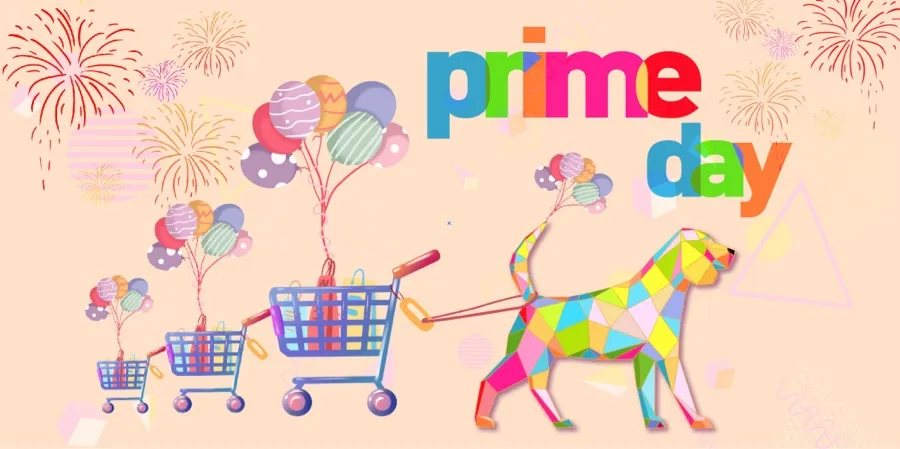The deadline to submit deals has long since passed, Amazon’s purchase orders have been placed, and vendors and sellers have packed their inventory, ready to be loaded on trucks if not already in transit to Amazon’s fulfillment centers. And now it’s official: today Amazon announced that Prime Day 2019 will begin at midnight on July 15th and run to the end of July 16th – a full 48 hours.
In anticipation of another record-breaking sales event, Amazon advertisers are gearing up to get the most out of Prime Day. In the past, many have simply upped their ad spend and left it at that – but that’s not going to cut it in 2019.
Every year since its inception, Prime Day has been one of the three most highly-trafficked days on Amazon. That means more competition on keywords and higher CPCs. In isolation, spending more should increase your chances of winning those keywords, but Prime Day is not just about higher traffic, it’s an event that inspires different kinds of consumer behavior. On Deal Days, shoppers are hunting for bargains, but they’re also caught up in the excitement and ready to spend a lot of money. So your marketing strategy should be tailored to particular shopping habits we tend to see on Deal Days.
With a little bit of understanding of what makes Prime Day unique coupled with strategic thinking about how to capitalize on that, you can save yourself from poor visibility and wasted ad spend on what ought to be among the most successful days in the retail year. Here are some of our best tips for where and when you should be driving traffic, and how to target your campaigns to the shoppers most likely to buy.
- Budget
In 2018, shoppers flooded Amazon.com as soon as Prime Day started, so much so that the site couldn’t handle the traffic. There were rolling outages that prevented most shoppers from using search (or accessing the site at all) throughout early hours of the day until Amazon installed temporary servers to accommodate the traffic. Despite these interruptions, most of the growth of the event took place during the first six hours. If anything, the media’s coverage of the traffic only helped to bolster awareness of the event.
This year, Amazon is ready for the traffic and you should be ready for the intense competition that comes with it. When thinking about your budget, you should consider what you want to get out of Prime Day, how much you’re willing to spend to meet your goals and how you can prevent overspending. In addition to being one of retail’s biggest sales events, your Prime Day performance will also be felt throughout the year. The spike in traffic and conversion that accompanies a successful Deal Day can cause a lift in organic search rank and the visibility and new customers gained can drive sales of your entire assortment long after the event.
That being said, Prime Day can also be a drain on your budget. With CPCs likely reaching new highs, some advertisers may decide it’s not worth the expense and instead decide to invest their marketing budget in the off-peak lead up and lead out in hopes of unlocking higher efficiencies. We suggest scaling your budget for each of the three periods: lead up, Prime Day, and lead out. What you’re bidding on, and how much, should vary between each. For example:
- During lead up you could bid aggressively on must-win keywords for products that are going to have the best deals to boost visibility and encourage pre-Prime Day browsers to load their shopping carts ahead of time.
- During Prime Day you might want to pull back from those expensive must-win keywords and increase bids on medium and long tail keywords where you find more efficiency.
- During lead out, many shoppers will be looking for add-ons and accessories for the big ticket items they just bought, so you could invest in terms and placement that target this shopping behavior.
Prime Day poses a big risk for overspending. If you don’t cap your campaign spend, the high level of competition can drive your CPCs up to unsustainable levels. Consequentially, if you’re too conservative with your keyword bids, you risk losing a term that could perform well for you. Limit the total spend of campaigns and set rules to reduce or eliminate spend on inefficient terms to allow for more aggressive spending on the best performers. And throughout the event, manually monitor and tweak your campaigns to increase/decrease bids based on your return.
2. Behavior
Shoppers eagerly anticipate Prime Day as an opportunity to finally get all those big ticket items they’ve had on their wishlists (and to be enticed by deals on items they didn’t know they wanted). To capitalize on this behavior, brands should focus investments in three areas:
- Premium Products
Demand for high priced products is consolidated around Deal Days, when shoppers’ usual tentative approach to these items is mitigated by the excitement of the event, the consumer trust that Amazon has earned, and the discounts available on many such items. It can be a good investment to focus your ad dollars on premium products during Prime Day and to target competitive items with Product Display Ads which showcase your deals. That being said, when competitive targeting, it’s important that your product is at a similar or lower price point as price can still be a barrier to conversion. As such, base and mid-tier products are also an important part of a successful Prime Day.
- Price-Agnostic Categories
On Prime Day most shoppers are on the hunt for deals, but some categories will always convert regardless of price. If you sell in categories where price is not the main motivator such as baby products (where shoppers want the highest quality regardless of price), the high traffic on Prime Day is an opportunity to gain visibility for deal and non-deal items alike through Sponsored Product and Sponsored Brand ads.
- Attached Products
On Deal Days, the latest in tech, appliances, and gadgetry tend to take center stage. Luckily for brands, shoppers that buy these products typically go on to buy many attached products as well, such as upgrades, accessories and recipe/instruction books. Amazon’s new Product Attribute Targeting functionality can effectively promote products that shoppers are unlikely to choose a variant of, such as video games for a specific console (new Switch owners aren’t going to buy the PS4 edition of a game just because it’s the cheaper option).
3. Timing
At midnight on July 15th, shoppers will once again flood Amazon.com to be the first to take advantage of Prime Day’s thousands of deals. This year we expect Amazon to be ready for the traffic, but that doesn’t mean that vendors will be ready for the keyword bid rush. As in previous years, it’s very likely that a high proportion of vendors will exhaust half of their budgets within the first three hours (some may even use all of their daily budgets in that time) as keyword bid competition drives up CPCs.
Consider manually pausing your campaigns until the bid rush is over to eliminate the risk of draining your budget. Starting campaigns at 6:00am should increase efficiency significantly, as some competitors will have already fallen out of the race and CPC prices may have passed their peak. Optimal times will vary by category and target audience, however, so we advise dayparting – adjusting your keyword bids to focus your budget during key strategic hours to maximize visibility, conversion and/or efficiency – using historic data to identify peak hours.
Amazon will also be doing things a little differently this year. For Prime Day 2018, which lasted 36 hours, many shoppers came back on the second day to search for new deals but found that the Spotlight Deals-of-the-Day ran for the full 36 hours. To add value for (and encourage) repeat visitors, this year Amazon will run shorter deals more frequently across the full two-day period, including the introduction of the new four-hour WOW Deals. So don’t forget about day two – keep your campaigns funded and optimized for the full 48 hours of Prime Day 2019.
4. Tracking
With record-setting volume of traffic and sales, Prime Day is a treasure trove of data. By tracking your share of voice (SOV) and organic search ranking before, during and after the event, you can arm yourself with the resources to optimize your marketing strategy for Q4. Black Friday and Cyber Monday are Prime Day’s only competitors in terms of search volume and sales, so make sure you’re testing, measuring, and learning so that you can be ready for a successful holiday season. Similarly, monitor your competitors’ activity and how it impacts your SOV to learn from their successes and failures and stay ahead of the game.
It’s important to set goals and define success beforehand. Did your investment in Amazon Advertising yield an increase in your organic search rank for top keywords? The opportunity posed by Prime Day is that the higher traffic and conversion will yield a residual life in organic search ranking that drives additional growth after the event. Outlining the results that you’re hoping to achieve to justify the investment of time and budget will help you set expectations, measure ROI, and plan for future Deal Days.
Planning your Prime Day strategy requires a significant time investment. Consolidating and analyzing search data from multiple sources, manually adjusting your bids throughout the day, and adapting your strategy based on performance in real-time are big tasks, but the effort will pay off in the form of a better and more efficient Prime Day performance. And we can help – Pacvue’s powerful and intuitive platform enables you to consolidate and visualize multiple data sources, identify the best actions to take, and programmatically manage and optimize your Amazon Advertising campaigns.
In 2018, most of the growth of Prime Day took place during the first six hours, despite the fact that outages meant many shoppers couldn’t search. Instead, shoppers loaded up their shopping carts ahead of time and then decided what to buy once the deals went live. Now that Amazon has announced the timing of Prime Day 2019, shoppers will start preparing their wishlists, which means that brands need to start getting their attention. Whatever your budget, using the above strategies will allow you to maximize the impact of your investment and prepare you to grow your sales before, during, and after Prime Day, through Q4 and into 2020.













